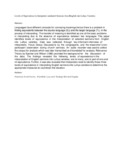Levels of Equivalence in Interpreter-mediated Sermons from English into Luhya Varieties
Date
2021-04Author
Khachula, Annet Aromo
Mandillah, Lucy
Mudogo, Bernard Angatia
Metadata
Show full item recordAbstract
Languages have different concepts for conveying meanings;hence there is a problem in finding equivalents between the source language (SL) and the target language (TL) in the process of interpreting. The transfer of meaning is identified as one of the basic problems in interpreting due to the absence of equivalence between two languages. This paper identifies levels of equivalence in the interpretation of selected sermons from English into Luhya varieties. Data was collected through key-informant interviews of interpreters, Focus Group Discussions by the congregants, and the researcher’s non-participant observation during church services. An audio recorder was used to collect the corpus for analysis which was later transcribed and translated for analysis. Relevance Theory by Sperber and Wilson (1986) provided the background for the discussion of the data. The findings revealed the following levels of equivalence in the interpretation of English sermons into Luhya varieties; one to many, one to part-of-one and nil equivalence. Further, it was also revealed that interpreters need to identify these three levels of equivalence in interpreting English sermons into Luhya varieties to determine the appropriate measures to counteract the situation.
URI
https://doi.org/10.32996/ijels.2021.3.5.4https://al-kindipublisher.com/index.php/ijels/article/view/1728
http://ir-library.mmust.ac.ke:8080/xmlui/handle/123456789/1959
Collections
- Journal Articles [411]

